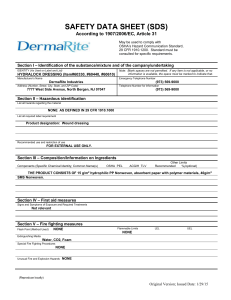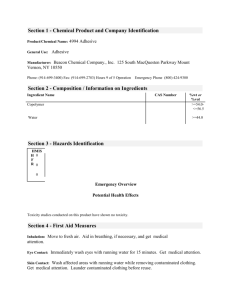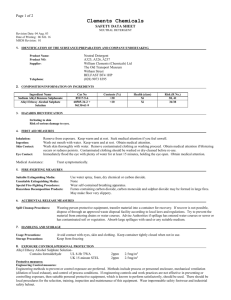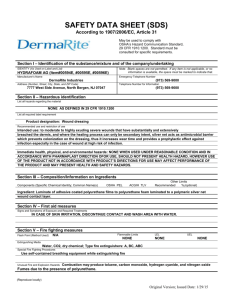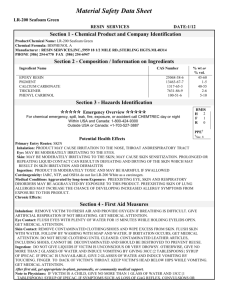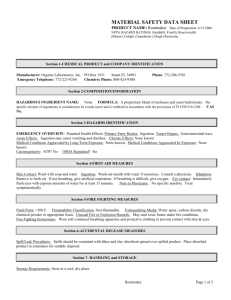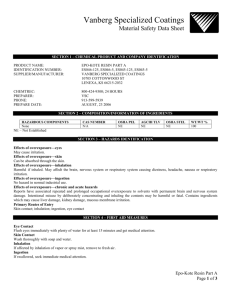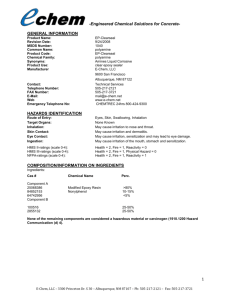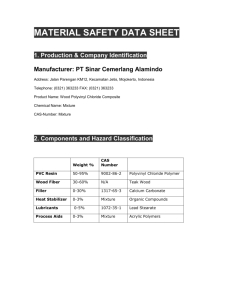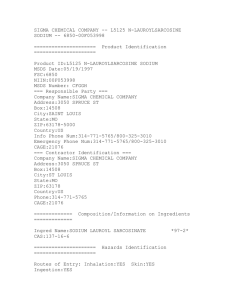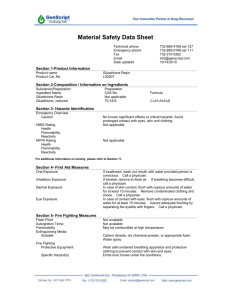Section 1 - Chemical Product and Company Identification
advertisement
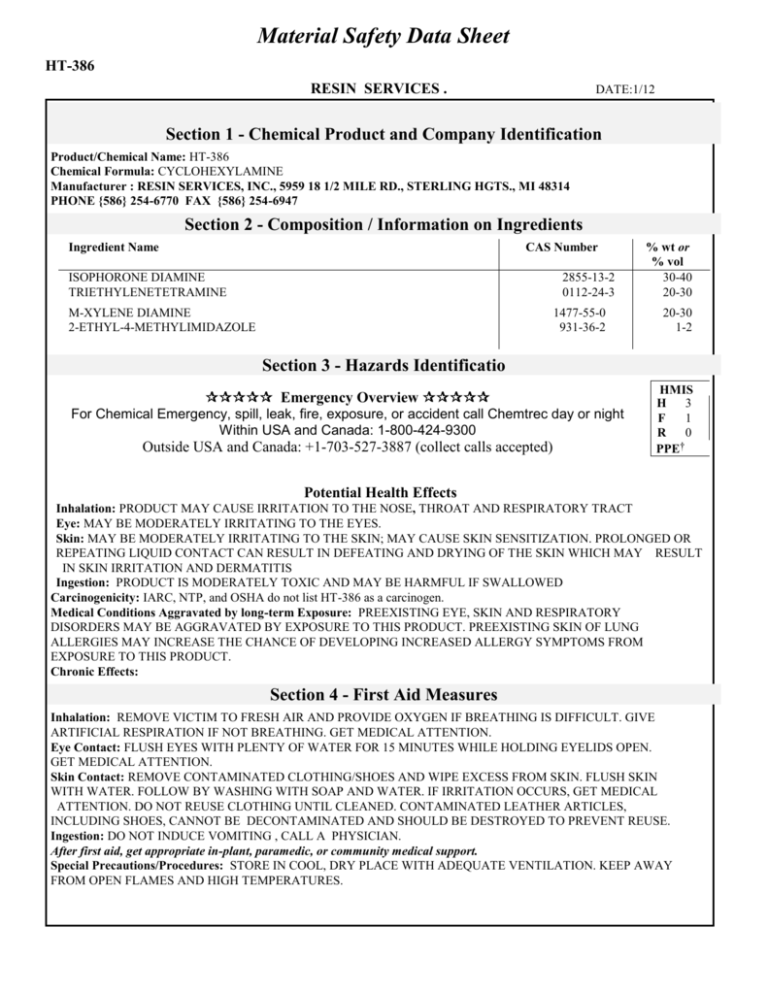
Material Safety Data Sheet
HT-386
RESIN SERVICES .
DATE:1/12
Section 1 - Chemical Product and Company Identification
Product/Chemical Name: HT-386
Chemical Formula: CYCLOHEXYLAMINE
Manufacturer : RESIN SERVICES, INC., 5959 18 1/2 MILE RD., STERLING HGTS., MI 48314
PHONE {586} 254-6770 FAX {586} 254-6947
Section 2 - Composition / Information on Ingredients
Ingredient Name
CAS Number
ISOPHORONE DIAMINE
TRIETHYLENETETRAMINE
2855-13-2
0112-24-3
M-XYLENE DIAMINE
2-ETHYL-4-METHYLIMIDAZOLE
1477-55-0
931-36-2
% wt or
% vol
30-40
20-30
20-30
1-2
Section 3 - Hazards Identificatio
Emergency Overview
For Chemical Emergency, spill, leak, fire, exposure, or accident call Chemtrec day or night
Within USA and Canada: 1-800-424-9300
Outside USA and Canada: +1-703-527-3887 (collect calls accepted)
HMIS
3
H
F
1
R
0
PPE†
Potential Health Effects
Inhalation: PRODUCT MAY CAUSE IRRITATION TO THE NOSE, THROAT AND RESPIRATORY TRACT
Eye: MAY BE MODERATELY IRRITATING TO THE EYES.
Skin: MAY BE MODERATELY IRRITATING TO THE SKIN; MAY CAUSE SKIN SENSITIZATION. PROLONGED OR
REPEATING LIQUID CONTACT CAN RESULT IN DEFEATING AND DRYING OF THE SKIN WHICH MAY RESULT
IN SKIN IRRITATION AND DERMATITIS
Ingestion: PRODUCT IS MODERATELY TOXIC AND MAY BE HARMFUL IF SWALLOWED
Carcinogenicity: IARC, NTP, and OSHA do not list HT-386 as a carcinogen.
Medical Conditions Aggravated by long-term Exposure: PREEXISTING EYE, SKIN AND RESPIRATORY
DISORDERS MAY BE AGGRAVATED BY EXPOSURE TO THIS PRODUCT. PREEXISTING SKIN OF LUNG
ALLERGIES MAY INCREASE THE CHANCE OF DEVELOPING INCREASED ALLERGY SYMPTOMS FROM
EXPOSURE TO THIS PRODUCT.
Chronic Effects:
Section 4 - First Aid Measures
Inhalation: REMOVE VICTIM TO FRESH AIR AND PROVIDE OXYGEN IF BREATHING IS DIFFICULT. GIVE
ARTIFICIAL RESPIRATION IF NOT BREATHING. GET MEDICAL ATTENTION.
Eye Contact: FLUSH EYES WITH PLENTY OF WATER FOR 15 MINUTES WHILE HOLDING EYELIDS OPEN.
GET MEDICAL ATTENTION.
Skin Contact: REMOVE CONTAMINATED CLOTHING/SHOES AND WIPE EXCESS FROM SKIN. FLUSH SKIN
WITH WATER. FOLLOW BY WASHING WITH SOAP AND WATER. IF IRRITATION OCCURS, GET MEDICAL
ATTENTION. DO NOT REUSE CLOTHING UNTIL CLEANED. CONTAMINATED LEATHER ARTICLES,
INCLUDING SHOES, CANNOT BE DECONTAMINATED AND SHOULD BE DESTROYED TO PREVENT REUSE.
Ingestion: DO NOT INDUCE VOMITING , CALL A PHYSICIAN.
After first aid, get appropriate in-plant, paramedic, or community medical support.
Special Precautions/Procedures: STORE IN COOL, DRY PLACE WITH ADEQUATE VENTILATION. KEEP AWAY
FROM OPEN FLAMES AND HIGH TEMPERATURES.
MSDS No.
HT-386
Revision:
Section 5 - Fire-Fighting Measures
NFPA
Flash Point: 234 °F (112°C)
Flash Point Method: DIN 51758
LEL: 1.2 %
UEL: N/AV
#
#
—
#
Extinguishing Media: USE WATER FOG, ”ALCOHOL” FOAM, DRY CHEMICAL OR C02.
Unusual Fire or Explosion Hazards: NO UNUSUAL HAZARDS.
Hazardous Combustion Products: NO UNUSUAL HAZARDS.
Fire-Fighting Instructions: Do not release runoff from fire control methods to sewers or waterways.
Fire-Fighting Equipment: Because fire may produce toxic thermal decomposition products, wear a self-contained breathing
apparatus (SCBA) with a full facepiece operated in pressure-demand or positive-pressure mode.
Section 6 - Accidental Release Measures
Spill /Leak Procedures: MAY BURN ALTHOUGH NOT READILY IGNITABLE.
Small Spills: TAKE UP WITH AN ABSORBENT MATERIAL AND DISPOSE OF PROPERLY.
Large Spills DIKE AND CONTAIN. REMOVE WITH VACUUM TRUCKS OR PUMP TO STORAGE/SALVAGE
MATERIAL; DISPOSE OF PROPERLY.
Containment: For large spills, dike far ahead of liquid spill for later disposal. Do not release into sewers or waterways.
Cleanup: FLUSH AREA WITH WATER TO REMOVE TRACE RESIDUE.
Regulatory Requirements: Follow applicable OSHA regulations (29 CFR 1910.120).
Section 7 - Handling and Storage
Handling Precautions: MINIMIZE ALL CONTACT WITH MATERIAL. WASH WITH SOAP AND WATER BEFORE
EATING, DRINKING, SMOKING, APPLYING COSMETICS OR USING TOILET FACILITIES.
Storage Requirements: STORE IN COOL, DRY PLACE WITH ADEQUATE VENTILATION.
Regulatory Requirements: NONE
Section 8 - Exposure Controls / Personal Protection
Engineering Controls:
Ventilation: Provide general or local exhaust ventilation systems to maintain airborne concentrations below OSHA PELs (Sec. 2).
Local exhaust ventilation is preferred because it prevents contaminant dispersion into the work area by controlling it at its source.
Administrative Controls:
Respiratory Protection: Seek professional advice prior to respirator selection and use. Follow OSHA respirator regulations (29
CFR 1910.134) and, if necessary, wear a MSHA/NIOSH-approved respirator. Select respirator based on its suitability to provide
adequate worker protection for given working conditions, level of airborne contamination, and presence of sufficient oxygen. For
emergency or nonroutine operations (cleaning spills, reactor vessels, or storage tanks), wear an SCBA. Warning! Air-purifying
respirators do not protect workers in oxygen-deficient atmospheres. If respirators are used, OSHA requires a written respiratory
protection program that includes at least: medical certification, training, fit-testing, periodic environmental monitoring,
maintenance, inspection, cleaning, and convenient, sanitary storage areas.
Protective Clothing/Equipment: Wear chemically protective gloves, boots, aprons, and gauntlets to prevent prolonged or
repeated skin contact. Wear protective eyeglasses or chemical safety goggles, per OSHA eye- and face-protection regulations (29
CFR 1910.133). Contact lenses are not eye protective devices. Appropriate eye protection must be worn instead of, or in
conjunction with contact lenses.
Safety Stations: Make emergency eyewash stations, safety/quick-drench showers, and washing facilities available in work area.
Contaminated Equipment: Separate contaminated work clothes from street clothes. Launder before reuse. Remove this material
from your shoes and clean personal protective equipment.
Comments: Never eat, drink, or smoke in work areas. Practice good personal hygiene after using this material, especially before
eating, drinking, smoking, using the toilet, or applying cosmetics.
Page 2 of 3
Revision:
HT-386
MSDS No.
Section 9 - Physical and Chemical Properties
Physical State: LIQUID
Appearance and Odor: COLORLESS ; FAINT AMINE
- LIKE ODOR
Vapor Pressure: 0.015 mm Hg at F (20 °C)
Vapor Density (Air=1): NOT VOLATILE
Water Solubility: APPRECIABLE
Boiling Point: 477 F {247 C}
Freezing/Melting Point:
% Volatile: NOT VOLATILE
Evaporation Rate: NOT VOLATILE
Density: 7.8 W.P.G.
Specific Gravity (H2O=1, at 4 °C): .94
Section 10 - Stability and Reactivity
Stability: HT-386 is stable at room temperature in closed containers under normal storage and handling conditions.
Polymerization: Hazardous polymerization cannot occur.
Chemical Incompatibilities: STRONG OXIDANTS , ACIDS
Conditions to Avoid: N/A
Hazardous Decomposition Products: Thermal oxidative decomposition of HT-386 can produce AMMONIA , BURNING WILL
PRODUCE TOXIC FUMES ; CO , NITRIC OXIDES , THERMAL DECOMPOSITION TEMPERATURE : 500 F {260 C}
Section 11 - Disposal Considerations
Disposal: Contact your supplier or a licensed contractor for detailed recommendations. Follow applicable Federal, state, and local
regulations.
Disposal Regulatory Requirements:
Container Cleaning and Disposal:
Section 12 - Transport Information
UN NUMBER:UN 1760
Shipping Name:
CORROSIVE,LIQUID,N.O.S.
(ISOPHORONEDIAMINE,TRIE
THYLENETETRAMINE)
CLASS 8, PG III
DOT, IMDG, ICAO, IATA
DOT Transportation Data (49 CFR 172.101):
Packaging Authorizations
a) Exceptions: 173
b) Non-bulk Packaging: 173
c) Bulk Packaging: 173
Quantity Limitations
a) Passenger, Aircraft, or Railcar:
b) Cargo Aircraft Only:
Section 13 - Other Information
Prepared By: RESIN SERVICES, INC.
Revision Notes:
Additional Hazard Rating Systems:
Disclaimer: This information is furnished without warranty, representation, inducement or license of any kind, except that it is
accurate to the best of Resin Services, Inc’s knowledge, or obtained from sources believed by Resin Services, Inc. to be accurate,
and Resin Services, Inc. does not assume any legal responsibility for use or reliance upon same. Customers are encouraged to
conduct their own tests. Before using any product, read its label.
Page 3 of 3
